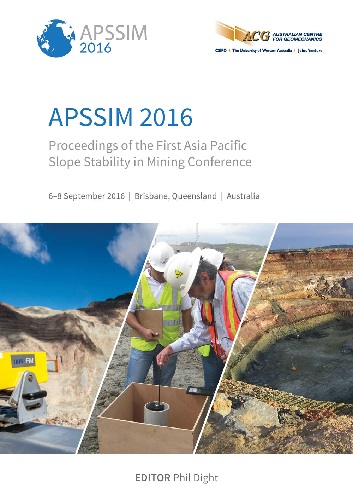Geotechnical analyses for risk management of a large scale failure at Century mine, Northwest Queensland

|
Authors: Sweeney, E; Abbott, K |
DOI https://doi.org/10.36487/ACG_rep/1604_11_Sweeney
Cite As:
Sweeney, E & Abbott, K 2016, 'Geotechnical analyses for risk management of a large scale failure at Century mine, Northwest Queensland', in PM Dight (ed.), APSSIM 2016: Proceedings of the First Asia Pacific Slope Stability in Mining Conference, Australian Centre for Geomechanics, Perth, pp. 225-238, https://doi.org/10.36487/ACG_rep/1604_11_Sweeney
Abstract:
The occurrence of large scale instability in open cut mines can have a detrimental impact to both safety and business of a mining company. As such it is crucial that the instability is effectively understood, communicated and managed to reduce both the likelihood and consequences of the failure and to keep the mine operational. During the period of January 2013 to December 2014, MMG’s Century mine successfully operated under a large-scale progressive wall failure and recovered more than 1.8 millions of tonnes of ore; with no incidents or near misses related to the numerous failures that propagated in this area during this time. This paper briefly describes the investigations undertaken to understand the failure mechanisms, as well as the expected size and extents of the failures. It further describes how the geotechnical team used this information, in conjunction with various forms of monitoring, to effectively reduce both safety and business exposure to the risks of wall failures.
Keywords: seismicity, slope performance, risk managment
References:
Barton, N 1976, ‘The shear strength of rock and rock joints’, International Journal of Rock Mechanics and Mining Sciences and Geomechanics Abstracts, vol. 13, no. 9, pp. 255–279.
Broadbent, CD & Zavodni, ZM 1982, ‘Influence of rock structure on stability’, Stability in Surface Mining, Society of Mining Engineers, vol. 3, Chapter 2.
Corominas, J 1996, ‘The angle of reach as a mobility index for small and large landslides’, Canadian Geotechnical Journal, vol. 33, pp. 260–271.
Finlay, PJ, Mostyn, GR & Fell, R 1999, ‘Landslide risk assessment: prediction of travel distance’, Canadian Geotechnical Journal, vol. 36, pp. 556–562.
Hungr, O, Corominas, J & Eberhardt, E 2005, State of the Art Paper #4 — Estimating landslide motion mechanism, travel distance and velocity, viewed 10 June 2016, ftp://www.eos.ubc.ca/pub/ohungr/Support/OH_Recent_Papers/SOA-4_Hungr.pdf
Lucas, D 2013, ‘Century Mine Geotechnical Review May 2013’, Report no. 3585, Internal Report, Mining One Consultants, Melbourne.
Sainsbury, B 2012, ‘Assessment of the Long Term Stability of the Stage 8 West Wall Cutback at MMG Century, Original Slope Design with Version 6 Buttress’, Report no. 13003, Itasca Consulting Group, Inc., Melbourne.
Sainsbury, B, Pierce, M & Mas Ivars, D 2008, ‘Analysis of Caving Behaviour Using a Synthetic Rock Mass (SRM) - Ubiquitous Joint Rock Mass (UJRM) Modelling Technique’ in Y Potvin, A Dyskin & R Jeffery (eds), Proceedings of the First Southern Hemisphere International Rock Mechanics Symposium, Australian Centre for Geomechanics, Perth, pp. 243–254.
Scheidegger, AE 1973, ‘On the prediction of the reach and velocity of catastrophic landslides’, Rock Mechanics, vol. 5, pp. 231–236.
Waltho, AE & Andrews, SJ 1993, ‘The Century zinc-lead deposit, northwest Queensland’, in IJ Duncan (ed.), The Australian Institute of Mining and Metallurgy Centenary Conference, Australasian Institute of Mining and Metallurgy, pp. 41–61.
© Copyright 2025, Australian Centre for Geomechanics (ACG), The University of Western Australia. All rights reserved.
View copyright/legal information
Please direct any queries or error reports to repository-acg@uwa.edu.au
View copyright/legal information
Please direct any queries or error reports to repository-acg@uwa.edu.au